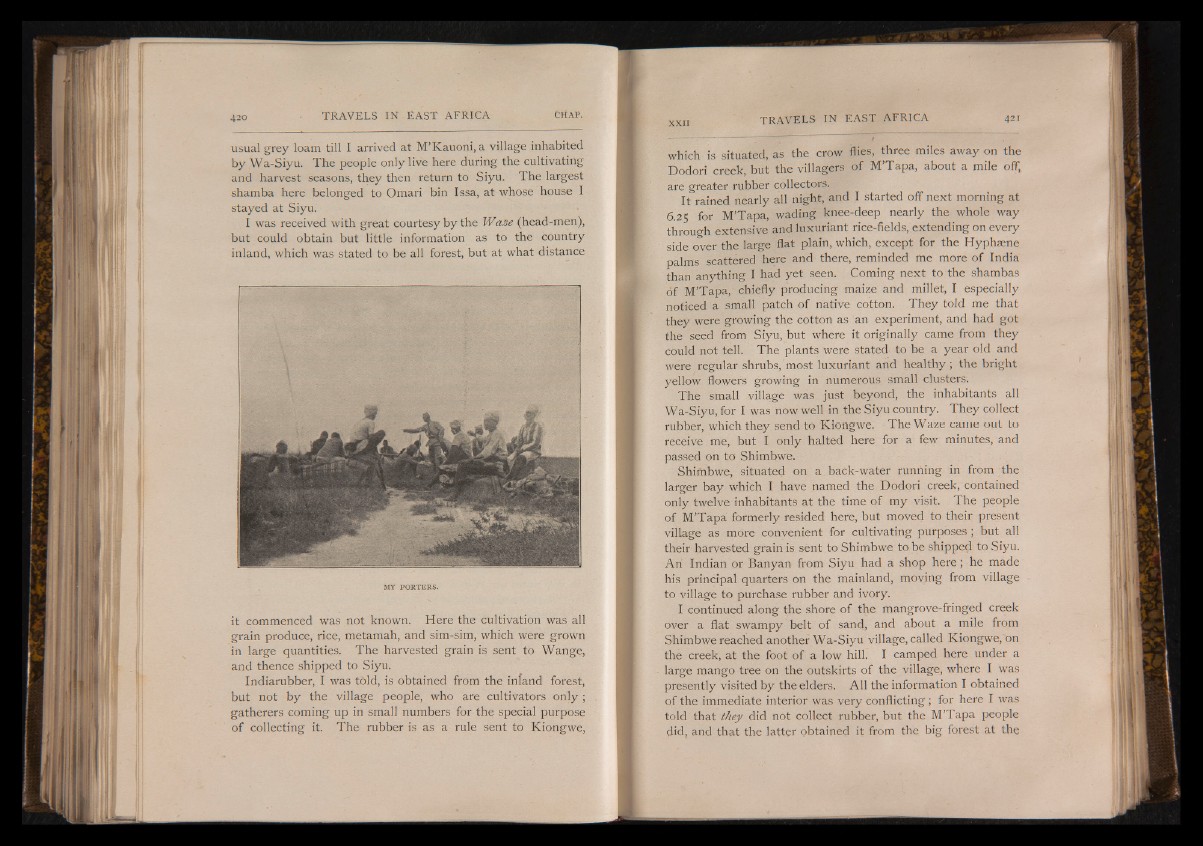
usual grey loam till I arrived at M’Kauoni, a village inhabited
by Wa-Siyu. The people only live here during the cultivating
and harvest seasons, they then return to Siyu. The largest
shamba here belonged to Omari bin Issa, at whose house I
stayed at Siyu.
I was received with great courtesy by the Waze (head-men),
but could obtain but little information as to the country
inland, which was stated to be all forest, but at what distance
MY PORTERS.
it commenced was not known. Here the cultivation was all
grain produce, rice, metamah, and sim-sim, which were grown
in large quantities. The harvested grain is sent to Wange,
and thence shipped to Siyu.
Indiarubber, I was told, is obtained from the inland forest,
but not by the village people, who are cultivators only ;
gatherers coming up in small numbers for the special purpose
of collecting it. The rubber is as a rule sent to Kiongwe,
which is situated, as the crow flies, three miles away on the
Dodori creek, but the villagers of M Tapa, about a mile off,
are greater rubber collectors.
It rained nearly all night, and I started off next morning at
6.25 for M’Tapa, wading knee-deep nearly the whole way
through extensive and luxuriant rice-fields, extending on every
side over the large flat plain, which, except for the Hyphaene
palms scattered here and there, reminded me more of India
than anything I had yet seen. Coming next to the shambas
of M’Tapa, chiefly producing maize and millet, I especially
noticed a small patch of native cotton. They told me that
they were growing the cotton as an experiment, and had got
the seed from Siyu, but where it originally came from they
could not tell. The plants were stated to be a year old and
were regular shrubs, most luxuriant and healthy ; the bright
yellow flowers growing in numerous small clusters.
The small village was just beyond, the inhabitants all
Wa-Siyu, for I was now well in the Siyu country. They collect
rubber, which they send to Kiongwe. The Waze came out to
receive me, but I only halted here for a few minutes, and
passed on to Shimbwe.
Shimbwe, situated on a back-water running in from the
larger bay which I have named the Dodori creek, contained
only twelve inhabitants at the time of my visit. The people
of M’Tapa formerly resided here, but moved to their present
village as more convenient for cultivating purposes; but all
their harvested grain is sent to Shimbwe to be shipped to Siyu.
An Indian or Banyan from Siyu had a shop here; he made
his principal quarters on the mainland, moving from village
to village to purchase rubber and ivory.
I continued along the shore of the mangrove-fringed creek
over a flat swampy belt of sand, and about a mile from
Shimbwe reached another Wa-Siyu village, called Kiongwe, on
the creek, at the foot of a low hill. I camped here under a
large mango tree on the outskirts of the village, where I was
presently visited by the elders. All the information I obtained
of the immediate interior was very conflicting; for here I was
told that they did not collect rubber, but the M’Tapa people
did, and that the latter obtained it from the big forest at the